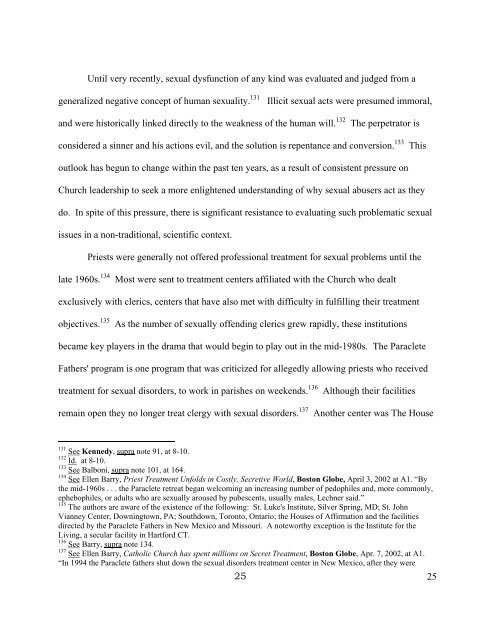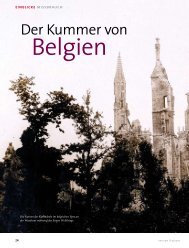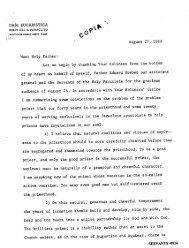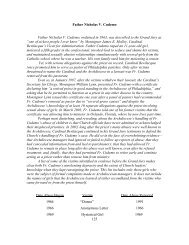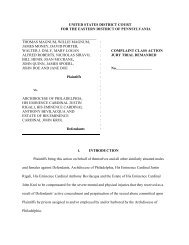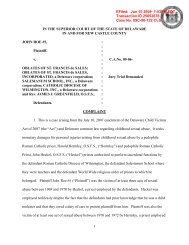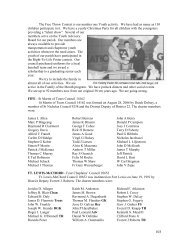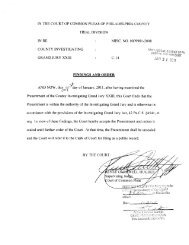1 1 Catholic Clergy Sexual Abuse Meets the Civil Law by Thomas P ...
1 1 Catholic Clergy Sexual Abuse Meets the Civil Law by Thomas P ...
1 1 Catholic Clergy Sexual Abuse Meets the Civil Law by Thomas P ...
You also want an ePaper? Increase the reach of your titles
YUMPU automatically turns print PDFs into web optimized ePapers that Google loves.
Until very recently, sexual dysfunction of any kind was evaluated and judged from a<br />
generalized negative concept of human sexuality. 131 Illicit sexual acts were presumed immoral,<br />
and were historically linked directly to <strong>the</strong> weakness of <strong>the</strong> human will. 132 The perpetrator is<br />
considered a sinner and his actions evil, and <strong>the</strong> solution is repentance and conversion. 133 This<br />
outlook has begun to change within <strong>the</strong> past ten years, as a result of consistent pressure on<br />
Church leadership to seek a more enlightened understanding of why sexual abusers act as <strong>the</strong>y<br />
do. In spite of this pressure, <strong>the</strong>re is significant resistance to evaluating such problematic sexual<br />
issues in a non-traditional, scientific context.<br />
Priests were generally not offered professional treatment for sexual problems until <strong>the</strong><br />
late 1960s. 134 Most were sent to treatment centers affiliated with <strong>the</strong> Church who dealt<br />
exclusively with clerics, centers that have also met with difficulty in fulfilling <strong>the</strong>ir treatment<br />
objectives. 135 As <strong>the</strong> number of sexually offending clerics grew rapidly, <strong>the</strong>se institutions<br />
became key players in <strong>the</strong> drama that would begin to play out in <strong>the</strong> mid-1980s. The Paraclete<br />
Fa<strong>the</strong>rs' program is one program that was criticized for allegedly allowing priests who received<br />
treatment for sexual disorders, to work in parishes on weekends. 136 Although <strong>the</strong>ir facilities<br />
remain open <strong>the</strong>y no longer treat clergy with sexual disorders. 137 Ano<strong>the</strong>r center was The House<br />
131<br />
See Kennedy, supra note 91, at 8-10.<br />
132<br />
Id. at 8-10.<br />
133<br />
See Balboni, supra note 101, at 164.<br />
134<br />
See Ellen Barry, Priest Treatment Unfolds in Costly, Secretive World, Boston Globe, April 3, 2002 at A1. “By<br />
<strong>the</strong> mid-1960s . . . <strong>the</strong> Paraclete retreat began welcoming an increasing number of pedophiles and, more commonly,<br />
ephebophiles, or adults who are sexually aroused <strong>by</strong> pubescents, usually males, Lechner said.”<br />
135<br />
The authors are aware of <strong>the</strong> existence of <strong>the</strong> following: St. Luke's Institute, Silver Spring, MD; St. John<br />
Vianney Center, Downingtown, PA; Southdown, Toronto, Ontario; <strong>the</strong> Houses of Affirmation and <strong>the</strong> facilities<br />
directed <strong>by</strong> <strong>the</strong> Paraclete Fa<strong>the</strong>rs in New Mexico and Missouri. A noteworthy exception is <strong>the</strong> Institute for <strong>the</strong><br />
Living, a secular facility in Hartford CT.<br />
136<br />
See Barry, supra note 134.<br />
137<br />
See Ellen Barry, <strong>Catholic</strong> Church has spent millions on Secret Treatment, Boston Globe, Apr. 7, 2002, at A1.<br />
“In 1994 <strong>the</strong> Paraclete fa<strong>the</strong>rs shut down <strong>the</strong> sexual disorders treatment center in New Mexico, after <strong>the</strong>y were<br />
25<br />
25


